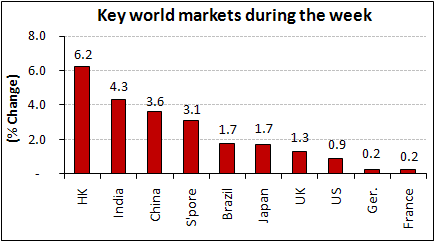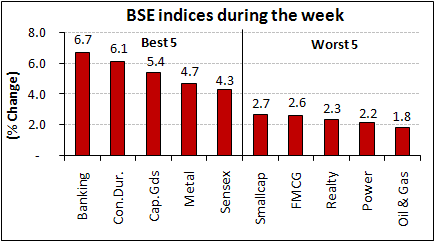India's Third Giant Leap
This Could be One of the Biggest Opportunities for Investors
- Home
- Todays Market
- Indian Stock Market News November 4, 2010
QE boost for world markets Thu, 4 Nov RoundUp
Stockmarkets across the world were up during the week on news of US Fed pumping US$ 600 bn into the economy. The biggest gainer of the week was Hong Kong, up 6.2% while the biggest laggard was France up 0.2%. India was the second biggest gainer up 4.3%. Among other Asian countries, China was up 3.6% while Singapore and Japan were up by 3.1% and 1.7% respectively. In Europe, UK was the top gainer, up 1.3% while Germany was up by 0.2%. In Americas Brazil was up by 1.7% while US was up by 0.9%.
 |
| Source: Yahoo Finance |
Moving on to the performance of sectoral indices in India - Banking and Consumer durables stocks were the most in favour this week with the BSE-Banking and BSE-Consumer Durable indices ending the week with gains of 6.7% and 6.1% respectively. The worst performing indices were BSE-Oil & Gas and BSE-Power with gains of 1.8% and 2.2% respectively. BSE-Capital Goods, BSE-Metals and BSE-Sensex were amongst the week's top five performers with gains of 5.4%, 4.7% and 4.3% respectively. BSE-Smallcap, BSE-FMCG and BSE-Realty with gains of 2.7%, 2.6% and 2.3% respectively were part of the worst 5 performers.
 |
| Source: BSE |
Moving on to key corporate developments during the week - a handful of companies announced their results for the quarter ended September 2010. Two-wheeler manufacturer Hero Honda released its results over the week. The results of the company were disappointing. Hero Honda's sales grew by 12% YoY during the quarter on the back of 9% YoY growth in volumes. The company sold nearly 1.3 m units during the quarter. However, on the operating margin level, the company's margins fell by 4.9% to 13.4%. This was the result of higher raw material costs face by the company during the quarter. In fact cost of raw material shot up from 68% in 2QFY10 to 73% in 2QFY11 (as a percentage of sales). The poor performance at operating income level affected the company's bottom line which fell by 15% YoY.
Hero Honda's competitor Bajaj Auto released its sales number for October. The company reported a sales volume of 370,816 units as compared to 280,455 units during the same month last year, an increase of 32.2% YoY. The company recorded the highest sales volume for motorcycles during the month. Sales of motorcycles increased by 32% YoY to stand at 329,776 units. Sale of commercial vehicles stood at 41,040 units making the balance sales volume. Exports increased at a marginally slower pace of 31% YoY during the month. For the current fiscal year, sales of the company stood at 2.3 m as compared to 1.5 m last year. During this period, motorcycle sales grew by 53% YoY, while commercial vehicle sales grew by 44% YoY. Motorcycle sales make up about 89% of the company's sales volumes, while commercial vehicles formed the balance.
In what could result in further pressure on margins for auto companies, tyre manufacturers are looking at hiking prices between 3% and 5% in the current quarter. This is on account of continuous pressure of rising raw material costs. Natural rubber prices have doubled from last year. Currently, rubber is selling at US$ 4,200 per metric tonne. While tyre prices have been revised, they could not keep pace with the rapidly rising costs. The raw material prices for the tyre industry have gone up by 47% this year. However the companies were able to pass on only 37% of the overall increase. Strong competition with strong demand is limiting companies to take price hike decisions. However, the indications are that the next round of price hikes is definitely in the pipeline.
Several pharma companies also declared their results this week. Aventis announced its 3QCY10 results. The company's net sales grew by 6% YoY during the quarter. This was led by the strong 15% YoY growth in sales from its core pharmaceutical business. However, growth was capped as a result of 22% YoY decline in exports. Operating margins declined marginally by 0.5% due to higher other expenditure as a percentage of sales. Bottom line grew by 8% YoY. This was at a faster pace than the growth in operating profits and was on account of higher other income. Going forward, the company's focus on delivering high quality healthcare to rural population as well as to enter the over-the-counter (OTC) market will aid future growth.
Aurobindo Pharma declared its 2QFY11 results. The company's top line during the quarter grew by a robust 26% YoY. This was largely led by a strong performance of its formulations business, which grew by 38% YoY. The Anti Retro Viral (ARV) and Rest of the World (ROW) markets were the key contributors to growth. US also did well to log in a growth of 29% YoY. The Active Pharmaceutical Ingredient (API) business disappointed as sales grew by 7% YoY. This was mainly due to the poor performance of the penicillin and ARV businesses. While sales of penicillin declined by 6% YoY, the ARV API business saw sales fall by 1% YoY. The cephalosporins API business was the only saving grace as it grew by 25% YoY and provided a boost to the overall growth of the API business. Aurobindo's operating margins fell by 0.6% during the quarter to 22.85. This was a result of increase in raw material and staff costs (as percentage of sales). The company's bottom line grew by a strong 92% YoY during the quarter. This was largely due to forex gains of Rs 762 m in 2QFY11 (as against forex losses of Rs 36 m in 2QFY10) partly offset by lower other income and higher tax expenses. When adjusting for forex gains, net profit growth was much lower at 14% YoY.
Sun Pharma also announced its 2QFY11 results during the week. Top line of the company grew by 16% YoY during the quarter. This was largely due to the strong performance of its domestic formulations business which grew by 36% YoY. The company's market share in the domestic market now stands at 3.7%. Its 5 key therapeutic areas in the chronic segment accounted for 75% of total domestic formulation sales. As far as the US generics business is concerned, this quarter saw Taro turn into an indirect subsidiary of Sun Pharma. For the quarter, sales of Taro stood at US$ 103 m although revenues of only 10 days have been taken into account in Sun Pharma's financials for the quarter. Caraco, meanwhile reported a growth of 25% YoY in sales. Operating margins declined from 37.7% in 2QFY10 to 34.1% in 2QFY11. This was largely due to higher raw material costs (as a percentage of sales). Net profits grew by 11% YoY which is faster than operating income. This was on account of lower tax expenses and depreciation charges.
| Company | 29-Oct-10 | 3-Nov-10 | Change | 52-wk High/Low | |
| Top gainers during the week (BSE-A Group) | |||||
| Rashtriya Chemicals & Fertilize | 95 | 123 | 29.5% | 125 / 58 | |
| National Fertilizers Ltd. | 117 | 139 | 18.1% | 149 / 50 | |
| Dish T V India Ltd. | 56 | 62 | 11.2% | 64 / 33 | |
| Great Eastern Shipping Co. Ltd. | 317 | 351 | 10.9% | 369 / 240 | |
| ACC Ltd. | 984 | 1083 | 10.1% | 1,093 / 700 | |
| Top losers during the week (BSE-A Group) | |||||
| Jain Irrigation Systems Ltd. | 232 | 222 | -4.2% | 264 / 147 | |
| Maruti Suzuki India Ltd. | 1551 | 1496 | -3.6% | 1,658 / 1,186 | |
| Reliance Industries Ltd. | 1096 | 1065 | -2.8% | 1,187 / 915 | |
| Jaypee Infratech Ltd. | 90 | 88 | -2.1% | 100 / 75 | |
| LIC Housing Finance Ltd. | 1339 | 1311 | -2.1% | 1,497 / 705 | |
In other economic news, The Reserve Bank of India (RBI) increased the repo rate to 6.25% and reverse repo to 5.25% in its monetary policy review. After presenting the monetary review, RBI's governor indicated that the bank would abstain from hiking rates further for at least 3 months. Moreover any further action will be driven by the growth and inflation situation and implications of external developments. The central bank believes that in recent months, the headline inflation has leveled out at moderated levels. However, the current rate of inflation is still above its comfort zone. This monetary review had seen the 6th such rate hike since the RBI took the decision to tighten its policy in January to curb inflation. For this fiscal, the bank has retained its growth forecast at 8.5%.
In international news, Federal Reserve announced that it will buy US$ 600 bn in long-term Treasuries over the next eight months. This is one more attempt to jump start the sluggish recovery. The Fed also announced it will reinvest an additional US$ 250 bn to US$ 300 bn in Treasuries with the proceeds of its earlier investments. The bond purchases - a policy known as quantitative easing (QE2)- will total up to US$ 900 bn and would be completed by the end of the third quarter of 2011. The federal funds rate is the central bank's key tool to spur the economy and a low rate is thought to encourage spending by making it cheaper to borrow money. However, as we have seen, the low rates have failed to get consumers and businesses to spend. As a result of this the Fed has decided to resort to more unconventional tool of quantitative easing i.e. to lower interest rates even further. But critics of QE2, including some Fed members, believe that too much monetary stimulus may led to runaway inflation that could derail the economy. It may also create future asset bubbles that could endanger economic stability over the long term.
In the past, infusion of liquidity has done more harm than good. This time around this infusion may also not have dissimilar results. While the markets are up on the euphoria of this infusion, we believe that one should be cautious while investing in the stock markets.
For information on how to pick stocks that have the potential to deliver big returns, download our special report now!
Read the latest Market Commentary


Equitymaster requests your view! Post a comment on "QE boost for world markets". Click here!
Comments are moderated by Equitymaster, in accordance with the Terms of Use, and may not appear
on this article until they have been reviewed and deemed appropriate for posting.
In the meantime, you may want to share this article with your friends!